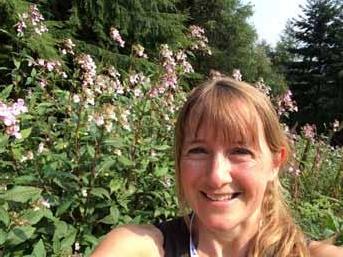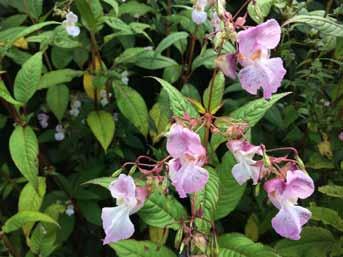
7 minute read
and rust fungus biocontrol
fungi that populate it, then we are more likely to protect them. If we are taught that our actions and everyday choices will directly or indirectly lead to the loss of much-loved species, then we may be prepared to behave differently. Natural History is now as important as any other subject in the school curriculum and should be taught at every level in education. Knowledge of species, ecosystems and natural resources has to be ingrained in every young person so that even if a child doesn’t develop a wonder at the natural world then they will at least be taught the importance of nature’s role in daily living. Natural History will need to be a part of teacher training and organisations like the Field Studies Council and the wildlife trusts will become ever more important in supporting schools. Sara Lanyon who many of you will know has been working passionately for both in Shropshire for years and has lately been instrumental in developing a Natural History GCSE. We will need to go beyond this, to the agricultural colleges where it is urgent to have a much more integrated programme of learning. Topics like conservation, ecological function and natural flood management have to be linked to every aspect of farming, from managing grassland for dairy herds to improving arable productivity. Young farmers and countryside managers are leaving college with little understanding of ecological systems and how farming impacts on them. Food production must not compromise the health of our ecosystems. If we don’t address this, then we will not only lose our wild spaces in Shropshire but we will be unable to sustain life on this planet. Thanks to success in receiving funding via the Water Environment Grant, run by Natural England and the Environment Agency, Shropshire Wildlife Trust (SWT) have set up the Shropshire Invasive Non-Native Species Initiative (SINNSI) project this year, collaborating with a variety of stakeholders. The project website, with more details, is available here: https://www.shropshirewildlifetrust.org.uk/ shropshire-invasive-non-native-species-initiative . Whilst much of the action on the ground for this project has to been postponed to 2021 due to coronavirus, Kirsty, Senior River Project Manager on the Rivers Team at SWT has been collaborating with the Centre for Agriculture and Bioscience International (CABI) scientists to facilitate release of a highly species-specific rust fungus biocontrol on small areas of the invasive nonnative Himalayan Balsam, Impatiens glandulifera in Shropshire. Himalayan Balsam is one of many invasive nonnative plant species. These invasives can pose a threat to native habitats, cost the economy and affect human and animal health in the UK. For a full list of invasive non-native species and the latest information for the UK, please see: http://www. nonnativespecies.org/ Research has shown that Himalayan Balsam is not only affecting native flora by outcompeting them, and leaving riverbanks more prone to erosion during winter, but is also luring pollinators away, leaving native species less ‘fit’, for example see: • Chittka, L., Schürkens, S. Successful invasion of a floral market. Nature 411, 653 (2001) available here: https://www.nature.com/ articles/35079676 . While the release of any rust fungus, especially from another country, can be cause for concern, CABI have undertaken extensive tests to meet UK rules and release of the rust fungus has been approved by DEFRA. In addition to an interesting video on YouTube showing CABI scientists searching for biocontrol agents in India
Volunteers at work (Photo by Holly Jones)
Advertisement
Invasive Non-Native Species: Himalayan Balsam and rust fungus biocontrol
Kirsty Brown
here: https://youtu.be/sk8dgh_h-34, a variety of research papers are available on the rust fungus, including: • Tanner, R.A., Pollard, K.M., Varia, S., Evans,
H.C. and Ellison, C.A. (2015), First release of a fungal classical biocontrol agent against an invasive alien weed in Europe: biology of the rust, Puccinia komarovii var. glanduliferae.
Plant Pathol, 64: 1130-1139. doi:10.1111/ ppa.12352 (available here: https://bsppjournals. onlinelibrary.wiley.com/doi/epdf/10.1111/ ppa.12352), • and, more recently: Ellison, CA, Pollard, KM & Varia, S (2020). Potential of a coevolved rust fungus for the management of Himalayan
Balsam in the British Isles: first field releases.
Weed Research 60 37 – 49 (available here: https://onlinelibrary.wiley.com/doi/ epdf/10.1111/wre.12403 ). There are a number of stages required prior to the release of the rust fungus biocontrol at a site. These include the following, with more detail below: • Finding suitable sites/gaining permissions • Collecting ripe seeds before drying and sending these to CABI • CABI laboratory work to develop the biocontrol specific to the plants at the chosen site • Training and application of the biocontrol.
Finding a suitable site:
To make use of the rust fungus biocontrol, firstly suitable sites need to be found that have high humidity, receive a good amount of sunshine during the day, and are not inundated for long periods/frequently washed out. Landowner permissions need to be sought, along with any permissions from Natural England (e.g. for designated sites) and the Environment Agency. The landowner also needs to be aware that a 10x10m area of Himalayan Balsam will need to be left intact for the rust fungus to infect. Normal Himalayan Balsam management can take place outside of this area. Community involvement is also encouraged, where possible.
Seed collection for CABI:
Next, come September, 200+ ripe, black seeds need to be collected from the selected site, from a range of the plants present. The seeds are collected by carefully placing a bag over the seed pods then shaking/gently squeezing to explode the pods, releasing the seed into the bag. Anyone who has touched a ripe seed pod will know these seeds fire out at all angles! These black seeds need to be laid out to dry on a tray for several days, until they turn grey-ish, separated by time and space from any other samples collected. Once dry, the seeds are packaged up with a unique identification, grid reference, date collected etc. and sent to the CABI team in Surrey.
Developing the biocontrol:
Over winter, the CABI team stratify the seeds, then, between January and June, they grow the seedlings on and attempt to match one of the rust fungus strains to the particular biotype of Himalayan Balsam received. It would appear that Himalayan Balsam has been introduced to the UK on multiple occasions and from a variety of sources, and the biotypes can differ based on where in Asia the Himalayan Balsam originated when it was first imported. The co-evolved rust fungus strains are so specific, that sometimes there is no match between host and biocontrol, and the host plants may be resistant to the rust fungus.
Application of the biocontrol:
If a successful match is obtained, CABI will then develop enough inoculum hand-spray for the chosen site, to treat a 3 x 3m area within the 10 x 10m selected patch. The CABI team will train the project leader on the best practice and method for inoculation. This usually involves using a small hand-held sprayer and spraying the underside of leaves in the evening/straight after rainfall, when it is cooler and more humid. The application takes

Himalayan Balsam seed collection, Pant Glas

Footpath to Rhosfach above Pant Glas - Himalayan Balsam
place three times over the course of the summer. Monitoring includes temperature and humidity measurements, along with infection assessments. The rust fungus should survive in the leaf litter and re-infect the site and beyond the following year, but if the rust fungus does not seem to have survived the winter at that site, a further spray application is included through CABI’s offer. The costs of this biocontrol is being funded by the SINNSI project at specific sites in Shropshire.
Helping pollinators and native flora:
Beekeepers are often concerned by the removal of this useful late-summer honeybee forage, but should be reassured that CABI state that pollinators will not be affected by this rust fungus, as it is so species-specific, and that the rust fungus acts quite gradually, allowing native flora to recolonise the site naturally. For the SINNSI project, we will also investigate re-seeding bare sites with local provenance seed mixes/seed mats, including wildflowers, to help reduce bank erosion and

Himalayan Balsam, Pant Glas restore native habitat and nectar/pollen sources. Anyone with a garden/outdoor space can help support bees and other pollinators by planting more suitable nectar and pollen-rich species. Some great examples are listed in the Ribble Rivers Trust/Bumblebee Conservation Trust leaflet on Managing Himalayan Balsam & Conserving Bees, available here: https://ribbletrust.org.uk/wpcontent/uploads/2015/01/Himalayan-balsam-andBeesC.pdf
Get involved:
If you are part of a local group that tackle invasive non-native species, and would like help with advertising your sessions to bolster volunteer help in 2021, do get in touch with Kirsty via InvasiveSpecies@ShropshireWildlifeTrust.org. uk . You can join Shropshire Wildlife Trust as a member to help support the continuation this kind of work (see: https://www.shropshirewildlifetrust. org.uk/join), and you can follow the SWT Rivers team on social media, where we will provide updates on this project from time to time, via: • Facebook (https://www.facebook.com/
LYMag7/), • Twitter (https://twitter.com/LYR_Shropshire) • and Instagram (https://www.instagram.com/ lyr_shropshire/). Kirsty Brown, kirstyb@shropshirewildlifetrust.org. uk








